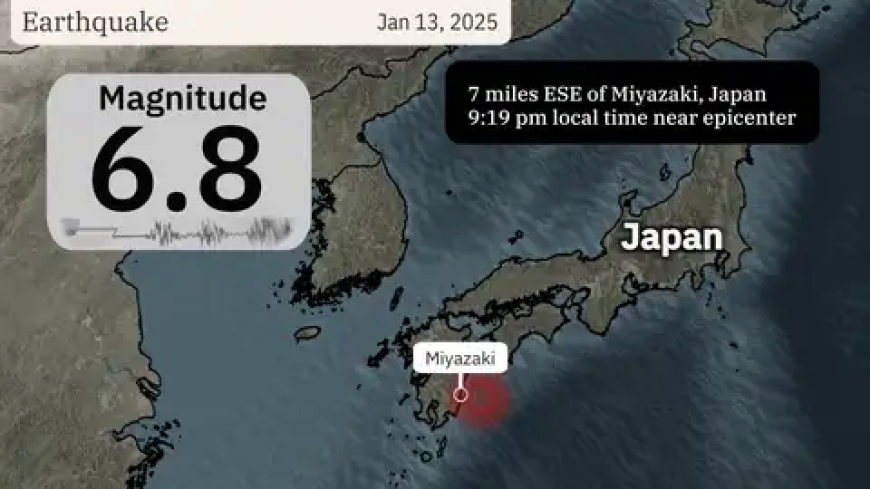japan earthquake tsunami warning
Learn about Japan's advanced earthquake and tsunami warning systems, how they work, and essential safety tips to stay protected during natural disasters. Stay informed and prepared.

Japan Earthquake and Tsunami Warnings: Understanding the System and Staying Safe
Japan is no stranger to the destructive power of earthquakes and tsunamis. As one of the most seismically active regions in the world, Japan has developed an advanced and sophisticated warning system to mitigate the risks associated with these natural disasters. However, despite these efforts, the unpredictability and power of nature make it crucial for residents and visitors alike to stay informed and prepared.
The Importance of Earthquake and Tsunami Warnings
Earthquakes and tsunamis often strike with little to no warning, making preparedness and timely alerts critical. The "Japan Earthquake Warning System" (JMA) and the "Tsunami Warning and Advisory System" are among the most advanced in the world. Their primary goal is to provide citizens with as much time as possible to take protective actions, such as evacuating, seeking shelter, or moving to higher ground before the worst of the disaster strikes.
Earthquake Warning System
The Japan Meteorological Agency (JMA) operates an earthquake early warning system that uses a network of sensors, known as seismometers, to detect seismic activity. The system is designed to issue alerts within seconds of detecting significant ground motion. The information is distributed through various channels, such as television, radio, mobile phones, and public loudspeakers.
Here’s how the system works:
- Detection: The system detects seismic waves traveling through the Earth. Primary seismic waves, which travel faster, are detected first. Secondary waves, which are more damaging, follow shortly after.
- Alert Issuance: Once detected, the JMA issues a warning with an estimated time to the arrival of the damaging seismic waves. These alerts are color-coded to indicate the expected intensity of the earthquake, ranging from mild to severe.
- Public Notification: Alerts are sent through a range of media, including mobile phone apps, public loudspeakers, TV, and radio broadcasts. These notifications allow people to take immediate action, such as dropping to the ground, taking cover, and holding on.
Although the warning time is often brief—sometimes only seconds to a minute—it has proven to be life-saving by allowing people to take protective actions and emergency services to prepare.
Tsunami Warning and Advisory System
Following a significant earthquake, especially along coastal areas, there is a heightened risk of a tsunami, a series of waves that can cause widespread flooding and devastation. Japan’s tsunami warning system is designed to provide alerts based on the magnitude of the earthquake and its location relative to coastal regions.
The warning system operates as follows:
- Earthquake Detection: When an earthquake of a certain magnitude occurs beneath the ocean or near the coast, the system instantly calculates the potential for a tsunami. The warning is based on the size, depth, and location of the earthquake.
- Tsunami Warning Levels: Japan issues three main levels of tsunami warnings:
- Tsunami Warning: This is issued for a tsunami with the potential to cause significant damage. It includes the predicted height of the waves and the affected regions.
- Tsunami Advisory: This warning is issued for smaller tsunamis that may still cause some damage but are not expected to be as devastating.
- Tsunami Information: Issued when the threat is minimal or non-existent. It helps prevent panic in coastal areas.
In addition to these warnings, the government has implemented evacuation procedures and the development of tsunami evacuation towers in vulnerable coastal areas.
How People Can Stay Safe
While Japan’s warning system is one of the most advanced globally, it’s essential for individuals to stay vigilant and prepared. Here are some key tips for staying safe during an earthquake or tsunami:
Earthquake Safety Tips:
- Drop, Cover, and Hold On: When the shaking begins, immediately drop to the ground, take cover under sturdy furniture or against an interior wall, and hold on until the shaking stops.
- Stay Indoors: If you are indoors, avoid running outside. Falling debris is one of the leading causes of injury during earthquakes.
- Stay Away from Windows: Glass and windows are fragile during quakes, and breaking glass poses a significant hazard.
Tsunami Safety Tips:
- Know the Evacuation Routes: If you live or visit a coastal area, make sure you know the nearest tsunami evacuation route and have a plan in place.
- Move to Higher Ground: After an earthquake, if you are near the coast and feel a strong tremor, move immediately to higher ground. Tsunamis can reach the shore quickly, often within 15 to 30 minutes of an earthquake.
- Avoid the Shoreline: After the earthquake, stay away from the beach and low-lying areas until the all-clear signal is given by authorities.
Japan’s Earthquake and Tsunami Preparedness: A Model for the World
Japan’s comprehensive early warning system, coupled with public education and preparedness campaigns, has saved countless lives during past disasters. The system is constantly evolving, with improvements in both detection technology and response times. For example, recent advancements in deep-sea monitoring devices and satellite systems allow for faster detection of potential tsunamis, providing even more time for evacuation.
Japan’s experience serves as a reminder of the importance of investing in early warning systems and disaster preparedness. While no system can predict or prevent all disasters, timely alerts can significantly reduce loss of life and property damage.
Conclusion
The Japan Earthquake and Tsunami Warning Systems are critical tools in the country’s ongoing effort to reduce the impact of natural disasters. The public’s ability to respond to these alerts can mean the difference between life and death. By staying informed, having a plan, and taking action when a warning is issued, everyone—residents and visitors alike—can play a role in minimizing the risk posed by these devastating forces of nature.

 Digital Talks
Digital Talks 





